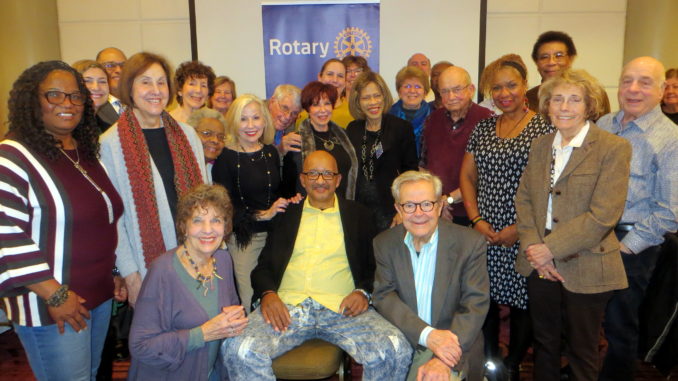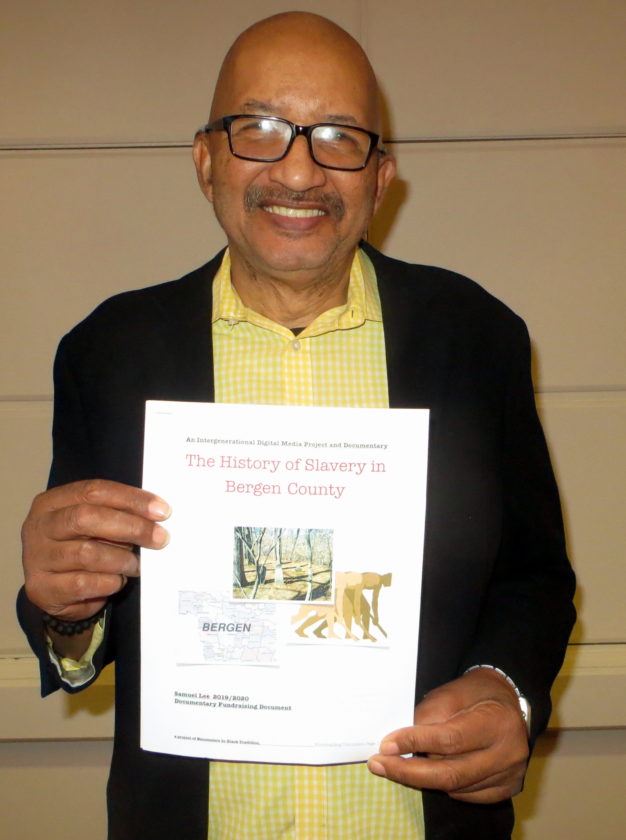
ENGLEWOOD, N.J.—Englewood resident Sam Lee’s documentaries are historical treasures. On Feb. 4, Lee reinforced that reputation at a Rotary Club of Englewood meeting.
The group of 40 Rotarians who met at the Crowne Plaza Hotel on North Van Brunt Street watched a segment of Lee’s fascinating film, “Remembering the 4th Ward of Englewood,” which he produced in conjunction with his nonprofit organization, Encounters in Black Tradition. The theme was especially relevant because February is Black History Month.
The presentation began as Lee talked about his professional film career, which took off in 1979, with a documentary he made titled, “In a Struggle for Youth Achievement,” that was shown on TV Channel 13 and Channel 31.
Twenty years later, Lee recalled that he came to Englewood because of an ad that promised “jobs of a lifetime paying $10 an hour.”
“People who responded to that ad were moved into the Fourth Ward that was designated for African American people.”
As Lee continued to fascinate the audience with recollections, Thomas “Moose” Monroe, the venerated Dwight Morrow High School coach who is Lee’s good friend and an Englewood historian, added additional information. Monroe has lived his entire life in the Fourth Ward, and, as such, knows many people and events of historical importance.
There followed a short video montage from Lee’s opus that depicted the legacy, history and contributions of the first African Americans in Englewood’s Fourth Ward and an anecdotal journey of their daughters, sons, grandchildren and great grandchildren.
“The Fourth Ward became home to African Americans who migrated to Englewood with strong southern roots,” Lee said.
The entire film can be viewed on YouTube. It includes archival photos of Englewood that date back centuries—the old railway station, Englewood Hospital, the Englewood Public Library, the Mackay School, Dwight Morrow High School, the Liberty School, Englewood City Hall, the Englewood Field Club, the Revolutionary Field House and the first Englewood Fire House.
There is also a panorama of well-known Englewood streets, such as Palisade Avenue, with horse-drawn carriages and vintage automobiles.
Lee’s film captures seminal events in the city, such as the march for school integration and the annual Jabari Society’s Juneteenth parade commemorating the end of slavery in America.
Some of the most interesting pieces of footage are interviews with longtime Englewood residents, such as Arnold Brown, Marlene Wyche Tinsley, Monroe, and Michelle McCloud-West, daughter of Dr. John McCloud.
Lee believes that, “talking to the community you begin to realize that the most important traces of a lost neighborhood are not traces found on city streets or filed in archives. They reside in a community as moments, sights and smells held in its imagination, the tools of personal interpretation we all possess.”

Lee then discussed his latest project, “The History of Slavery in Bergen County,” that is being funded in part by the Puffin Foundation.
“When I started researching this project, I went to the library and looked through the book on Englewood that had been published in the 1980s. There were only three African Americans mentioned in the book, and I knew that there had to be more to the story of African Americans in Englewood.”
So, Lee set about gathering and digitalizing a huge collection of information. He interviewed dozens of individuals in numerous communities, including people whose great-grandparents lived during the era of slavery.
“Once you know somebody’s story, you have a common bond,” he said. “This project has been a wonderful journey and I look forward to doing much more.”
He added, “The History of Slavery in Bergen County is proving to be very interesting. In the 17th century, Bergen County had more slaves than any other county in New Jersey. For every five white people there was one slave. Through research, I am trying to document the slave narrative.”
Although Lee’s work captures many challenging historical moments when racism was widely practiced, the overall theme is inspirational.
“African Americans in this community started as a single thread of unskilled laborers, domestic workers and servants and wove this yarn into a rich tapestry of diverse, talented and acclaimed individuals.”
